Note: for the full suite of measurements on the DS Audio DS 003 phono preamplifier from the SoundStage! Audio-Electronics Lab, click this link.
 It’s rare to find anything under the sun that’s truly new in the world of analog LP playback. Since the advent of the LP—and even going back to the first 78—the sun has risen and set on the same technologies. A turntable has one main job, namely, spinning the disc at a specific and constant speed. The tonearm needs to hold a cartridge and move in a precise manner with as little friction as possible. The phono stage? For nearly 70 years now, its job has been to amplify the punky little signal put out by the cartridge, and then invert the RIAA equalization.
It’s rare to find anything under the sun that’s truly new in the world of analog LP playback. Since the advent of the LP—and even going back to the first 78—the sun has risen and set on the same technologies. A turntable has one main job, namely, spinning the disc at a specific and constant speed. The tonearm needs to hold a cartridge and move in a precise manner with as little friction as possible. The phono stage? For nearly 70 years now, its job has been to amplify the punky little signal put out by the cartridge, and then invert the RIAA equalization.
And the cartridge? Well, it’s also been around a while—it’s been about 70 years since the genesis of the moving-coil and moving-magnet cartridges, which use tiny coils and tiny magnets attached to tiny cantilevers to generate tiny little electrical signals from the microscopic variations in the record grooves.
It’s hard to imagine a more archaic, buggy-whip technology surviving into this century, especially given the world we currently live in. Think about it: we’re flying a helicopter on freaking Mars for crying out loud.
In the 20-odd years that I’ve been writing for SoundStage!, I’ve reviewed a number of turntables, cartridges, and phono stages, and I’ve enjoyed them all. But—for obvious reasons—they’ve all done the same thing, in much the same way. And for the most part, they’ve all sounded more similar than they did different.
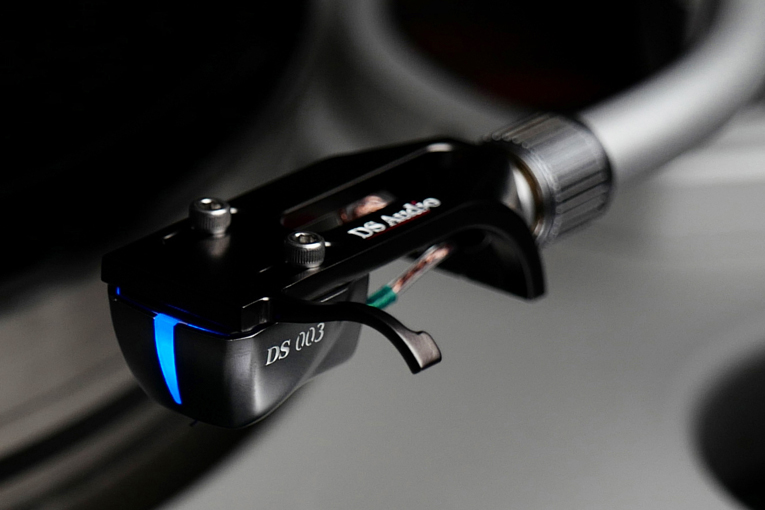
And then, dumped into my lap one cool March day, comes the DS Audio DS 003 optical cartridge and its matching DS 003 phono stage, together comprising the DS Audio DS 003 System, which is most decidedly 21st-century in both its design and execution.
Not the same-old
I often devote about a third of any given review to outlining a product’s technical details, but with analog products, sometimes less is required—around a quarter of the review will normally suffice. This makes sense, as there’s not much really happening inside a cartridge or a turntable. It’s all fine points, such as build materials, design choices, aesthetic details, and the like. The basic parameters of what the component needs to do and how it needs to do it have been set in stone for longer than I’ve been alive.
Until now, that is. What we’ve got here is an optical cartridge, one that doesn’t rely on magnets and coils to generate an electrical signal, and—for the most part—it’s a total paradigm shift. There’s no coil, no magnets, and the cartridge itself is an active component! So there’s lots to go over here. Please bear with me as I go through it because it’s worth it.
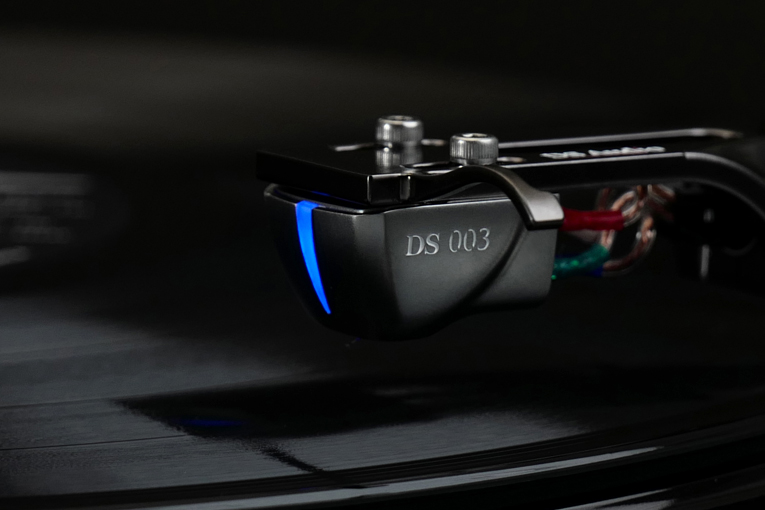
First off, the basics. It’s forgivable that you might think an optical cartridge would use lasers, or some such gubbins other than a stylus, to read the actual groove. But that’s not the case here. The DS Audio DS 003 cartridge uses an old-fashioned line contact stylus attached to an aluminum cantilever. But that’s the end of the road for similarities. There are LEDs inside the DS 003 cartridge. They shine toward the rear of the cartridge, and at the back are sensors—“photo detectors” in DS Audio’s parlance. Between the LEDs and the photo detectors is a thin, lightweight plate attached to the cantilever that casts a shadow over the sensors. As the stylus tracks the record, the plate moves and varies the shadow it casts on the sensors, allowing more or less light to hit them. This variation in light generates an analog (not a digital) signal.
Of course, the LEDs in the cartridge need power, and the signal the cartridge generates is substantially different from that generated by a conventional magnet-and-coil setup. This points to the need for a dedicated phono stage, one that can a) supply power to the cartridge and b) handle the amplitude-proportional signal output by the optical cartridge (magnetic cartridges generate a velocity-proportional output). Thus the need for the matching DS 003 phono preamplifier.
The power is transferred to the cartridge via the two negative legs of the four conductors in a standard tonearm phono cable. The two positive conductors supply the left and right signal output.
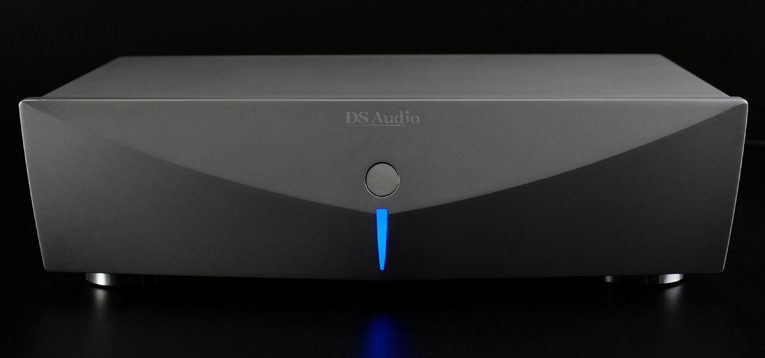
The DS 003 phono preamplifier sports single-ended outputs and is sparse in its connectivity. There’s the input for the one cartridge and two separate outputs, with each output featuring a different low-frequency roll-off. Combining the two outputs with a frequency selection switch enables four different choices of rumble filter.
There are two huge differences between the signal that comes out of the DS 003 optical cartridge and the signal generated by a conventional magnetic cartridge. The first is the output level. The DS 003’s photo detector generates a 70mV signal. To put this into perspective, the average moving-coil cartridge outputs 0.5mV and a moving-magnet cartridge can squeeze out 5mV or so. And what’s one of the biggest enemies of an analog signal coming from a record? Noise, that’s what. The unbelievably low output of a magnetic cartridge—especially an MC cartridge—means that the entire LP signal chain (from cartridge to phono cable to phono stage) needs to employ heroic efforts to keep noise out of the system. Certain phono cables of my experience have picked up signals from foreign-language radio stations that I’m fairly sure didn’t originate on this continent. So a magnetic cartridge is always fighting noise. Since we’re talking about a signal 14 times larger than the one an MM cartridge is capable of outputting, the signal generated by the DS 003 cartridge has a far easier time of it, and it’s far less prone to noise.
The other difference between the DS 003 and a magnetic cartridge is the way it interprets the RIAA-encoded signal. The technical description is rather complex, and if you’re interested, I suggest you check out DS Audio’s website. However, here’s the express version for those who found that TL/DR: due to the way the optical cartridge interprets the encoded groove, way less equalization is required to output the corrected signal.
Within the cartridge itself, there are a couple of big differences—advantages, really—between the optical and conventional magnetic paradigms. First, the moving mass of the beryllium shading plate is much lower than that of either a magnet or a coil. That means it can react with greater speed to the movements generated by the LP groove. Further, it’s not fighting resistance from magnetic forces, which—again—increases speed.
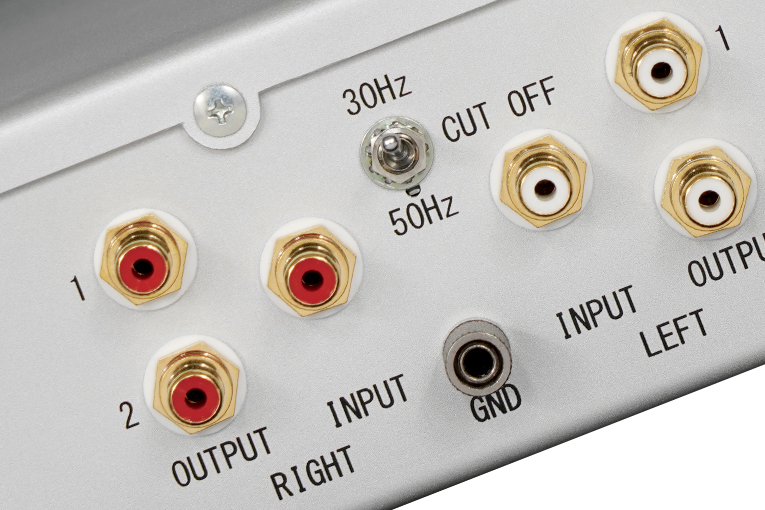
Since the DS 003 cartridge and phono stage make up a closed system, there’s no point in discussing cartridge impedance or gain. The only really relevant specs here are cartridge weight, which is an unremarkable 7.7gm, and the channel separation, which DS Audio gives as 27dB.
So DS Audio sells the DS 003 cartridge and phono stage as a matched set. They’re priced separately, though. The cartridge retails for $2500 and the phono stage for $3500 (all prices in USD). So that’s $6000 for the system. DS Audio has a number of other products in its lineup, from the entry-level DS E1 System at $2750 up to their DS Grand Master System at $60,000. Of course, you can mix and match phono stages with cartridges to build your own setup, but I’d imagine the components in each system are specifically chosen to complement each other, so I’d probably stay with their component choices.
A cartridge retip will set you back $1500, and the work must take place at DS Audio’s factory, which is in Japan. The company specifies that this process will take four to six weeks.
There are a number of refinements contained in that tiny little nugget, most notable, separate LEDs and photo receptors for each channel, along with the aforementioned beryllium shading plate.
However, it does need to be said that the actual concept of an optical cartridge isn’t brand new. The first optical cartridges were pioneered back in the 1960s, but in those days LEDs weren’t commercially viable. So those first-generation cartridges had an incandescent bulb jammed into that tiny space, and heat plus limited bulb life rendered these earlier efforts a good idea that had come much too early.
DS Audio itself is a sort-of side gig for the much larger Digital Stream Corporation, which manufactures industrial laser optics, so the company had the research and manufacturing capability to dig deep into the optical cartridge concept and refine it into the product that is currently residing in my listening room.
While word limits don’t always exist when it comes to online reviews, I think I’m running the risk of losing your attention here. But if you find you want more of the technical detail behind the DS Audio optical cartridge concept, head on over to the company’s website, where there’s a heap more information available in their white paper section.
It can’t be this simple
“You set it up just like any other cartridge!” chirped Garth Leerer of Musical Surroundings, the US distributor for DS Audio products, as I looked warily at a cartridge unlike any I’d ever had in my system. Surely it couldn’t be that simple?
Well, yeah, it was in fact that simple.
I removed the overachieving Sumiko Celebration 40 MC cartridge from my VPI JMW 10 tonearm and screwed in the DS 003 cartridge via its threaded mounting holes. The DS 003’s body is smooth and rounded, but the presence of a well-designed stylus guard made the whole process easy and relatively stress free. There’s no trickery with the cartridge pins—they’re labeled with the four standard colors we’ve come to know and love.
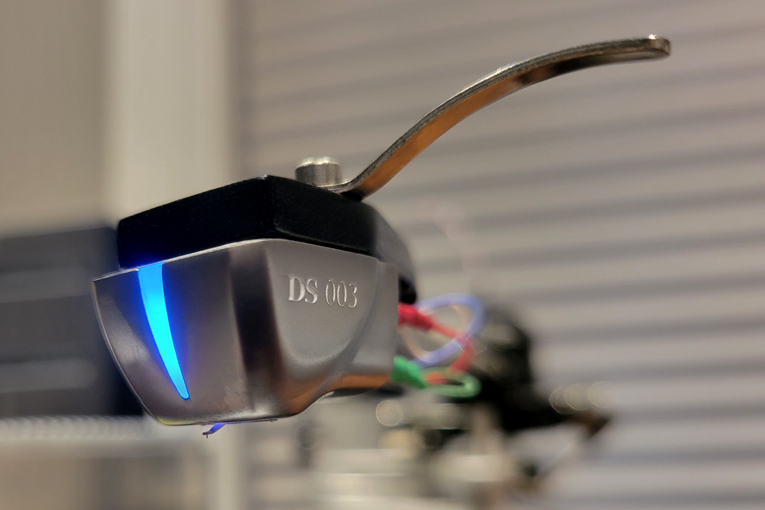
Sight lines under the cartridge are decent thanks to the gently sloping sides of the body. I had no trouble aligning the cartridge via VPI’s supplied jig. Once aligned, I set the weight to 2.0 grams and then hooked my Nordost phono cable up to the DS Audio DS 003 phono stage. Having no issues with rumble in my system, I attached the cables leading to my Sonic Frontiers SFL-2 preamplifier to the DS Audio’s 30Hz filter outputs and selected the 6dB roll-off.
So as I said earlier, the cartridge’s LEDs get power from the phono stage via the tonearm cable (there’s one blue LED in the front that’s just a power indicator and other infrared LEDs on the inside you can just barely see radiating out of the bottom of the cartridge when it’s on the record). However, there’s no need for any special cables—all power requirements are accommodated via your stock wiring. Once everything was hooked up, I attached the Musical Surroundings Fozgometer to the output of the phono stage and was delighted to see that my visual calibration of the cartridge’s azimuth was near as dammit bang-on correct.
From this point on, other than checking the cartridge alignment once more, I felt no need to fuss with the setup. For the first month, I left the phono stage powered up as per DS Audio’s suggestion, and turned it off at the end of day after that time.
The DS 003 cartridge tracked just great, and the stylus was very quiet in the groove. The noise floor of the attendant signal coming out of the DS 003 phono stage was below that of my Sonic Frontiers SFL-2 preamp.
Time to listen
I really wasn’t sure what to expect from this analog front end that was so unlike any other I’d experienced, and I dropped the needle onto the first record with just the slightest feeling of trepidation.
That first album was Duke Ellington’s Indigos (LP, Columbia CS 8053 / Impex IMP6010). I played it from start to finish, then flipped it over and listened to it all the way through a second time. Indigos is sparse, atmospheric music that’s masterfully recorded, resulting in an enveloping acoustic that can simply take your breath away. I often turn to this record when I want to find out how a component treats subtlety and the shadings between loud and soft and whether it can render space in a convincing manner.
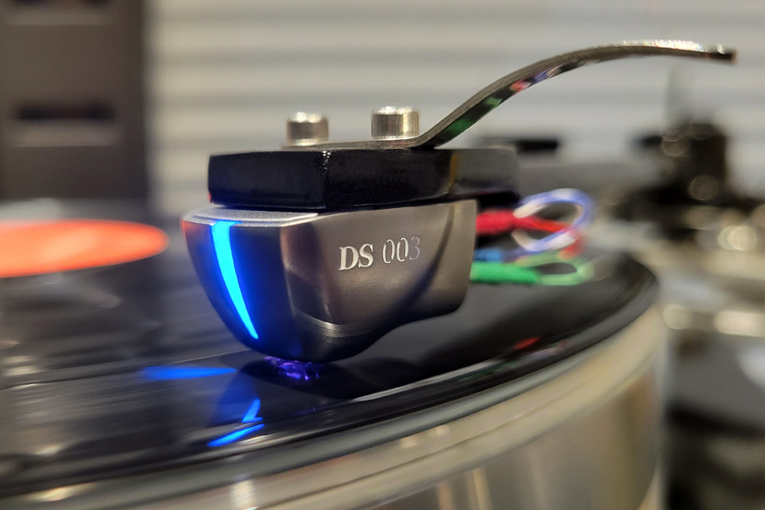
I sat there listening to Indigos with my mouth hanging open. The sense of the hall, the large studio in which the album was recorded, was all around me, and every instrument took on a physical size that really took me by surprise. The horns gained a sense of dynamic slam that I didn’t think was possible in my system. This sense of size and power didn’t come at the expense of the lush, jam-filled richness that drips from this record. All the hallmarks of this LP that I know and love were still there, but now they were accompanied by insane attack from the leading edge of every instrument, huge dynamic swings, and a sense of clarity and vivid imaging that made me stop what I was doing and sit there, transfixed.
“Willow Weep For Me” starts off with a mass of horns and reeds, and for the first time, I could pick out each instrument as an individual unit rather than hearing them en masse. And at the point when Shorty Baker’s trumpet kicks in, it was almost like a physical assault.
This will take some time to sort out, I recall thinking. Indigos through the DS 003 combo was an absolutely astonishing presentation, and I’d return to this album many times as the review period progressed.
Sticking with old-man jazz for a short spell, I threw the Thelonious Monk Quartet’s Monk’s Dream (LP, Columbia / Music on Vinyl MOVLP842) on to the VPI. That speed thing jumped out at me. It felt like I was crawling around inside the recording. The attack on every instrument—the almost contiguous feeling of Monk’s fingers hitting the keys, the action of the piano that moved the hammers that struck the strings, and then the sound reflecting out of the piano and striking the wood of the lid—it was all there, presented in a way that was utterly different from how I’m used to hearing music in this system.
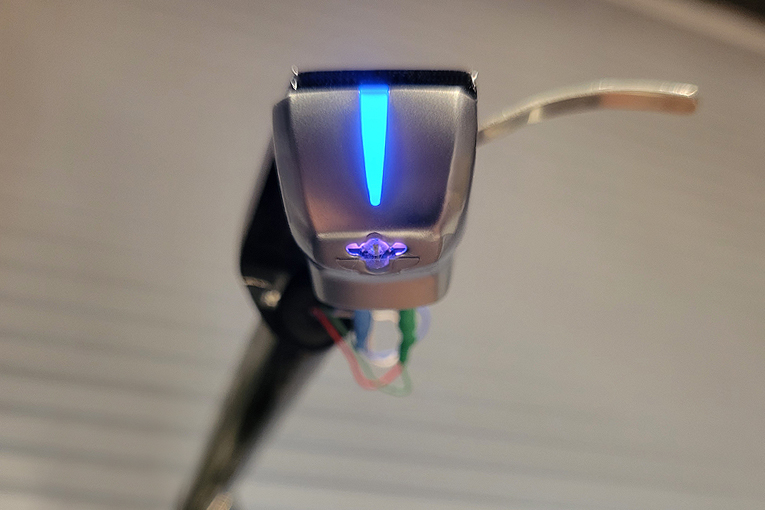
Same thing with Frankie Dunlop’s drums. The snap of his snare just leaped off the record and out of the speakers at me. The leading attack of the drumstick on the drum head was truly exceptional. Extending upward to the ride cymbal on “Five Spot Blues,” I got a full dosage of silkiness, extension, and the sensation of the actual touchdown of stick to metal was hyperreal.
Extension in the treble was magnificent. It’s huge how the DS 003 reaches up to what sounds like never-ending highs, but with an attendant ease and lack of strain. The DS 003 rockets upward with clarity and smoothness, with these two attributes almost fighting each other to see which will win out. It’s almost contradictory how this works, and it’s present even on overtones and harmonics from instruments we don’t usually think of as having an extended treble.
Going back to Monk’s piano on “Body and Soul,” I could hear distinct harmonics from his right hand playing, far, far above the fundamental. This sounds like an odd little detail—something that doesn’t seem that profound—but it sure as hell is important here, as it leads right from the extended treble I was just talking about into perhaps the most important reason the DS 003 combo is such a hot tamale.
Pulling those harmonics out of a high piano note is just one example of how the DS 003 extracts huge dollops of detail from the groove. It seemed as if, on every record I played, I heard new details, things either totally hidden, or—more often—just buried within the musical noise floor. The DS 003’s outstanding dynamic snap also helped here, I think, so it’s a combination of outstanding dynamics and low-level retrieval of detail joining forces to project an enveloping acoustic.
I know I’m writing chunks of this review in a sort of stream-of-consciousness Ulysses-like way. But that’s what happens when I get excited by a component—my fingers move like they’re being guided by a Ouija board, and I want to get this all down for you so that you can vicariously experience some of what I’m hearing. So please bear with me.
Over the years I’ve found myself drawn deeper and deeper into the world of John Zorn’s music. There’s a magic to Zorn’s juxtaposition of light and dark, of calm peace and explosive rage, often in the same song. As a side benefit, by listening to just one Zorn album, I can glean enough musical insight to really deconstruct a component’s inner essence.
The Last Judgment (LP, Tzadik TZ 6009) is a difficult listen (I spent a good 30 minutes trying to write this next paragraph and eventually had to wait for the end of the album as I couldn’t pay attention to anything but the music). One moment it’s smooth, spacey, minor-chord jazz, next thing you know it’s exploding in all directions, with Mike Patton losing his shit and every instrument raging at full tilt. It’s a journey that’s best experienced with the lights out. “Misericordia” begins with found surf sounds and bird calls, with an ominous undercurrent supplied by John Medeski’s organ. Listening to this noodling opening, I found myself focusing on the subtle, just-below-the-surface snare work of Joey Baron, and it truly startled me when Patton starts hissing what sounds like a sorcerous incantation. As the song builds it becomes truly terrifying, especially in the dark without any physical cues to the positions of the speakers.
I know this album very well, and listening to it at high volume through the DS 003 was an event, an almost transcendent experience. There was that ease in the treble combined with infinite extension I mentioned at length earlier, right through the almost magical delineation of the varying instruments. Both of these aspects combined to generate crisp, solid, juicy images of instruments and voices, placed distinctly in space, with depth and realism that I can’t recall experiencing in my listening room prior to the arrival of the DS Audio cartridge and phono stage.
Up to now I haven’t really discussed the DS 003’s bass performance. It’s down in the basement where the DS 003 is merely really good. This isn’t a slight, and I’m not damning it with faint praise. It’s just that really good doesn’t live up to the performance of the rest of this astonishing component.
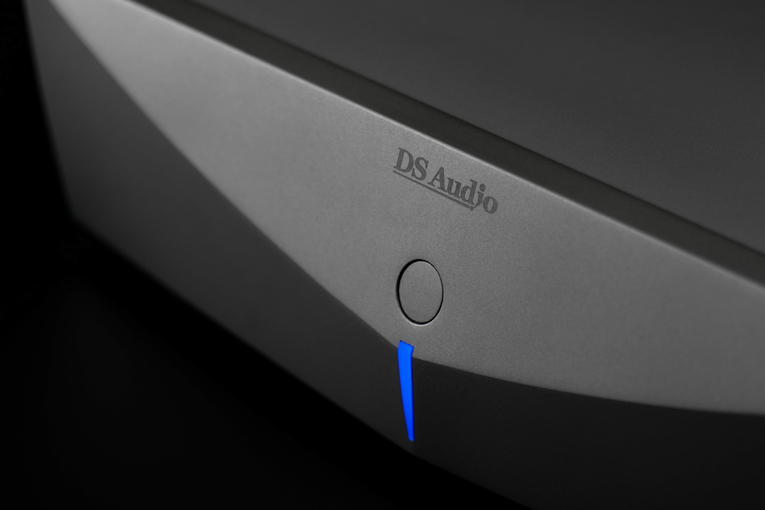
With the rumble EQ set to its least intrusive setting (-6dB at 30Hz), I got a rich, plummy low end, with superb extension, and almost-but-not-quite world-class delineation of each individual component.
I just did something I haven’t done in years. I ended a listening session with John Zorn’s Song Project boxed set, which consists of a bunch of 7″ 45-rpm discs, and I didn’t switch the VPI’s pulley back to the 33-rpm setting. The next morning I nipped out to my local record shop and, on the recommendation of my buddy Marc Dixon, splurged on the new Resonance Records’ reissue of Bill Evans’s Morning Glory (LP, Resonance HLP-9061).
Yep. I sat down and listened through the first two sides at 45 rpm, thinking to myself that it sounds a bit tinkly-tink, like he’s getting paid by the note. And, my word, audiences sure clap in a strange way down in Buenos Aires. It wasn’t until I put on another record that I know well that I realized my error. So here I sit now, listening through the recording at the right speed, and there’s tons of all-over-the-place bass work from Eddie Gomez. The DS 003 did a great job of following those up-and-down bass runs, and as Gomez dropped down to the bottom, the system energized the room, just as it should. There was plenty of delineation between the bass and Marty Morell’s kick drum, and Evans’s left hand. Absolutely nothing to complain about here, but it only sounded great instead of otherworldly, like the DS 003 does from the lower midrange on up. Is this a complaint or is it high praise indeed? I’m really not sure, but being a reviewer, I have to find something to bitch about.
Sometimes you just want to cuddle
As the review period progressed, I became more and more enamored, more and more astonished with how much resolution the DS Audio system dredged from records that I thought I knew so well. I’d be sitting there, listening to a favorite album—take your pick from the records I’ve listed above—and I’d find myself shaking my head at little details I hadn’t noticed before, or at least ones that hadn’t really grabbed my attention prior to a listen via this setup.
And I’d find myself wondering if perhaps the DS 003 might be just a bit too much for some people.
After all, vinyl, for the most part, sounds lusher and more romantic than digital. Just like tubes and electrostatic speakers, vinyl tends to take the edge off reproduced sound and render it as just a touch more human. Of course, that’s not the entirety of vinyl’s appeal. I’ve lived with and loved vinyl for decades now, and there are a number of reasons why I prefer vinyl’s portrayal of music, and those reasons are above and beyond the simple fact that the sound is romanticized.
So I honestly don’t think that every analog fan is going to appreciate the crisp, detailed, almost hyperrealistic presentation of the DS 003. Not because it’s a bright, or aggressive, or otherwise objectionable presentation, because it most definitely is not that. No, rather it’s because over the decades we’ve become used to the soft, cuddly, slightly cushiony sound of conventional LP playback, and the DS 003 is different.
But I think that only a very small percentage of listeners might feel this way. I’ve had a number of visitors over for extended listens. Of those, Rich uses a full Conrad-Johnson amplification chain and Ron runs a Leben tube integrated amplifier pushing Tannoy speakers, both using high-end vinyl front ends. And both of these listeners, who value palpability of image and ease of presentation, were right impressed with the DS Audio DS 003 System. They both recognized the additional resolution the DS003 offers along with the speed and the clarity, and they both loved its portrayal of images and scale.
What’s it worth to ya?
If you’re considering value, there are a couple of different ways of looking at the DS 003. First off, you can’t really view this combo as two separate components since the cartridge requires a matching optical phono stage, and there are very few of those out there. So what you’re looking at with the DS 003 System is really a complete $6000 analog front end. Looking at it from this perspective, I hereby proclaim the DS 003 to be an astonishing value. I’ve had a couple of pieces of extremely expensive analog equipment in my system and really, I haven’t heard any of them top the sound quality of the DS 003 System.
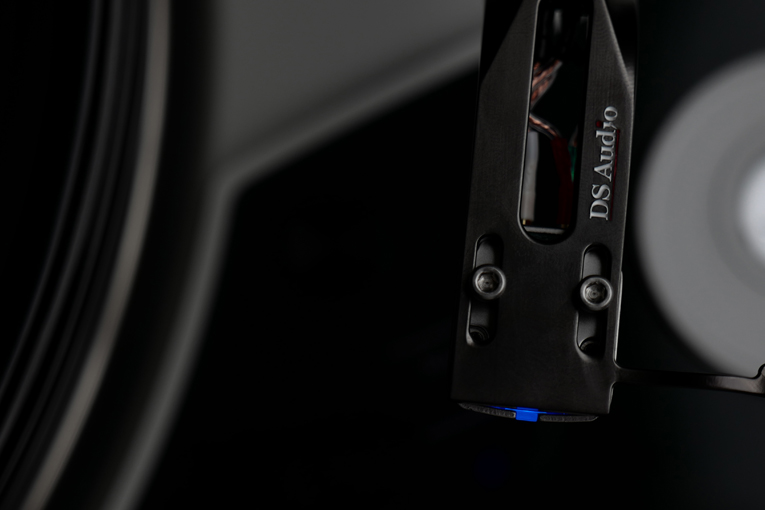
Look. The $12,500 Top Wing Blue Dragon cartridge combined with the $25,000 Constellation Revelation Andromeda phono stage has, to this point, been my benchmark, please-bury-me-with-it, high-water mark for analog front ends. While it’s been a few years since I had this combination in my system, I recall the way it affected me—the power, the resolution, the dynamics and imaging. That said, I honestly think the DS 003 sounds better in pretty much every way.
I understand that I’ve talked up the DS Audio setup to what may appear to be an unreasonable degree, and that, given reviewers’ propensity toward hyperbole, you the reader might feel that it could never be that good. Well, it is, and at $6000, including phono stage and cartridge, it’s an absolute steal. If you’re shopping for either a new cartridge or a new phono stage and have around six grand to spend, I think you’d be crazy if you didn’t consider the DS 003 System.
Postscript: this story isn’t over
Stand by readers. If you’ve shorted Amazon stock over the first six months of 2022 and have some extra cash rattling around in your savings account, you may want to tune-in for the next installment of the DS Audio optical cartridge story.
It seems I’m not the only one who’s totally taken aback by the paradigm-smashing performance of this company’s products. Ed Meitner, the president of EMM Labs, who’s probably forgotten more about audio engineering than most of us will ever know, has also been smitten by DS Audio cartridges. And he’s designed and manufactured his own phono preamplifier, the $12,500 DS-EQ1, which I’m about to hook up to the DS 003 cartridge.
This should be good!
. . . Jason Thorpe
jasont@soundstagenetwork.com
Note: for the full suite of measurements on the DS Audio DS 003 phono preamplifier from the SoundStage! Audio-Electronics Lab, click this link.
Associated Equipment
- Analog sources: VPI Prime Signature turntable; EAT Jo No8, Sumiko Celebration 40 catridges.
- Digital source: Logitech Squeezebox Touch.
- Phono preamplifiers: Aqvox Phono 2 CI, iFi Audio iPhono3 Black Label, Hegel Music Systems V10.
- Preamplifier: Sonic Frontiers SFL-2.
- Power amplifier: Bryston 4B3.
- Integrated amplifiers: Hegel Music Systems H120, Eico HF-81.
- Speakers: Focus Audio FP60 BE, Estelon YB, Aurelia Cerica XL.
- Speaker cables: Audience Au24 SX, Nordost Tyr 2.
- Interconnects: Audience Au24 SX, Furutech Ag-16, Nordost Tyr 2.
- Power cords: Audience FrontRow, Nordost Vishnu.
- Power conditioner: Quantum QBase QB8 Mk.II.
- Accessories: Little Fwend tonearm lift, VPI Cyclone record-cleaning machine, Furutech destat III, Musical Surroundings Fozgometer azimuth meter.
DS Audio DS 003 Cartridge and Phono Preamplifier System
Price: $6000.
Warranty: One year parts and labor.
Digital Stream Corporation
4-50-40,Kamitsuruma-Honcho
Minami-ku
Sagamihara
Kanagawa
252-0318
Japan
Phone: +81-427-47-0900
Website: ds-audio-w.biz






















